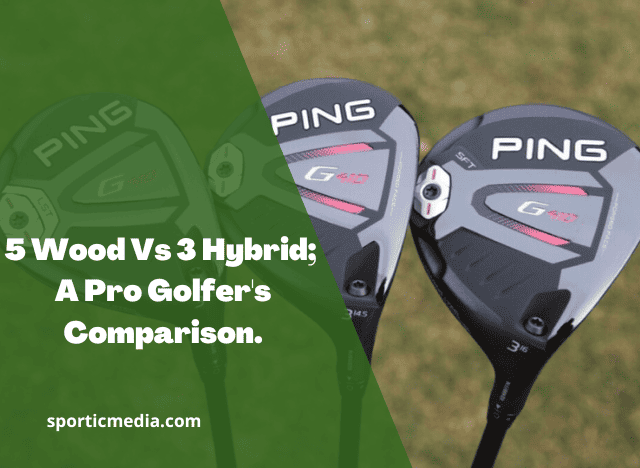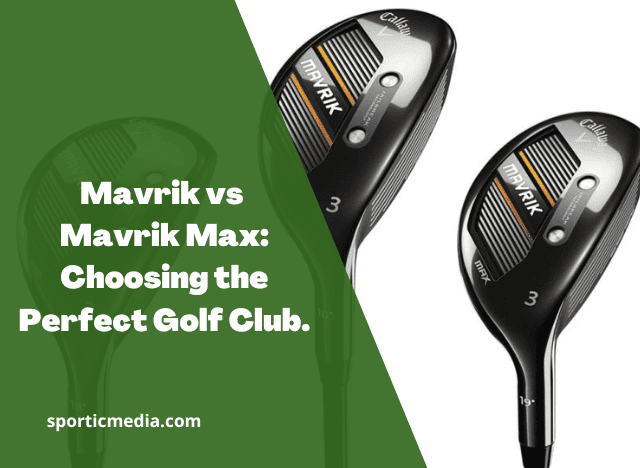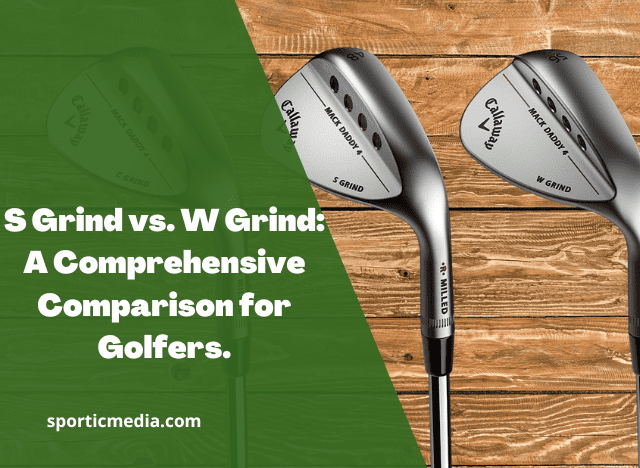The choice between a 5 wood and a 3 hybrid in golf revolves around distance, trajectory, and forgiveness. A 5 wood offers greater distance with a lower trajectory, ideal for skilled golfers seeking precision. Meanwhile, a 3 hybrid provides versatility, forgiveness, and a higher launch, making it suitable for a broader range of players and conditions.
This article breaks down their key differences in terms of loft, distance, forgiveness, and more, helping golfers make an informed decision about which club best suits their game.
Table of Contents
What’s the difference between a wood and a hybrid?
Woods and hybrids differ significantly in design and usage. Woods have larger, rounder heads made typically of metal, designed for long-distance shots from the tee or fairway. They offer a higher ball flight and are more forgiving on off-center hits due to their larger clubhead.
Hybrids, combining features of woods and irons, have smaller, more iron-like heads. They are versatile, easier to hit than long irons, and useful in various situations, including rough and fairway.
Hybrids provide a balance of distance and control, with a higher ball flight than irons but less distance compared to woods, making them ideal for replacing long irons in a golfer’s bag.
What is 5 Wood?
A 5 wood is a golf club designed for long-distance shots. It features a clubhead with a loft typically around 18 degrees, which is higher than a 5 iron but lower than a 3 wood. This moderate loft provides a balance between distance and height, making it suitable for various fairway and tee shots.
The 5 wood is valued for its ability to launch the ball with a relatively flat trajectory, making it effective on windy days and firm fairways. It requires a golfer’s precision and offers a compromise between the forgiveness of hybrids and the distance of fairway woods, making it a versatile addition to a golfer’s bag.
What to know about 3 Hybrid?
A 3 hybrid is a versatile golf club that combines the characteristics of a long iron and a fairway wood, providing golfers with a reliable option for various golfing situations. Here’s what you should know about it:
- Loft: A 3 hybrid typically has a loft ranging from 19 to 21 degrees. This loft is higher than the equivalent long iron (e.g., 3 iron), making launching the ball into the air easier.
- Usage: The 3 hybrid is designed for a wide range of shots, from long approach shots on par-4s and par-5s to challenging lies in the rough. It’s also a popular choice for tee shots on long par-3s when you need distance and accuracy.
- Distance: While a 3 hybrid may not offer the same distance as a traditional 3 wood, it provides more forgiveness and ease of use. Golfers can expect consistent distance and a higher ball flight.
- Forgiveness: 3 hybrids are known for their forgiveness, thanks to their larger clubheads and lower centers of gravity. This feature makes it easier to make solid contact and achieve consistent ball flight.
- Versatility: The 3 hybrid is a versatile club that can be used in various situations, including fairway shots, tee shots, and rough lies. It’s especially valuable when you need to hit the ball high and stop it quickly on the green.
- Setup: To hit a 3 hybrid effectively, golfers typically use a setup similar to their iron setup, with the ball positioned slightly forward in the stance. This setup allows for better control and launch.
- Course Conditions: A 3 hybrid is often chosen when golfers need to hit the ball high, such as on wet days when they want to prevent excessive roll after landing, or when navigating challenging lies in the rough.
- Customization: Like other golf clubs, you can customize a 3 hybrid to fit your swing characteristics. Factors like shaft flex, shaft length, and grip size can be tailored to your preferences.
In summary, a 3 hybrid is a valuable addition to a golfer’s bag, offering versatility, forgiveness, and ease of use. It bridges the gap between long irons and fairway woods, making it a go-to club for various playing conditions and situations.
What are the pros and cons of 3 Hybrid?

Pros of a 3 Hybrid:
- Versatility: The 3 hybrid is a versatile club that can handle various situations, from fairway shots to tee shots and rough lies.
- Forgiveness: It offers forgiveness due to its larger clubhead and lower center of gravity, making it easier to make solid contact even on mishits.
- Launch and Height: The higher loft of a 3 hybrid allows for a higher launch angle, helping the ball get in the air more easily, making it suitable for players who struggle with low ball flight.
- Control: While it provides distance, it also offers control, allowing golfers to shape their shots and navigate challenging course conditions.
- Distance: While not as long as some fairway woods, a 3 hybrid offers consistent distance and accuracy, making it a reliable option for longer shots.
- Stopping Power: It excels at stopping the ball quickly on the green, which can be crucial for approach shots.
Cons of a 3 Hybrid:
- Limited Distance: It may not provide the same distance as a 3 wood or even some longer irons, which can be a drawback when maximum distance is required.
- Learning Curve: While forgiving, it may take some time to adjust to the feel and playability of a hybrid for players accustomed to traditional irons.
- Reduced Roll: Due to its higher launch, the ball may not roll as much after landing, which can be a disadvantage on firm fairways.
- Trajectory Control: For players who prefer to control the trajectory of their shots, especially keeping them low, a 3 hybrid might not be the ideal choice.
Customization: Getting the right shaft and clubhead setup for your swing may require professional fitting, which can add to the cost.
In summary, a 3 hybrid offers many advantages, including versatility, forgiveness, and the ability to launch the ball high and stop it quickly. However, it may not provide the maximum distance of some other clubs, and it may take some adjustment for those more accustomed to traditional irons.
Best Low Compression Golf Balls; Reveiling The Top 5 Balls
sporticmedia.com
How to choose a 3 Hybrid?
Choosing the right 3 hybrid involves considering your swing speed, skill level, and course conditions. If you have a slower swing speed or are a beginner, prioritize a 3 hybrid with a more flexible shaft for improved launch. For faster swingers, opt for a stiffer shaft.
Test various 3 hybrids to find one that suits your feel and preference. Custom fitting can optimize your choice by tailoring shaft length, flex, and other factors to your swing characteristics. Additionally, consider the course conditions you frequently encounter; a 3 hybrid is beneficial in situations that require higher ball flight and soft landings.
5 Wood Vs. 3 Hybrid; Complete Comparison

Here’s a detailed comparison between a 5 wood and a 3 hybrid in a table format:
| Feature | 5 Wood | 3 Hybrid |
|---|---|---|
| Loft | Typically around 18-21 degrees | Typically around 19-21 degrees |
| Distance | Generally longer than a 3 hybrid | Slightly shorter than a 5 wood |
| Use | Best for long fairway shots, second shots on par 5s | Versatile for various shots, including rough and fairway |
| Forgiveness | Less forgiving than a hybrid | More forgiving, especially on off-center hits |
| Ball Flight | Higher trajectory leading to softer landings | Lower trajectory, more roll on landing |
| Control | Offers more control and shaping of shots | Easier to hit for beginners and offers decent control |
| Club Head Design | Larger head, resembling a smaller driver | Compact head, resembling an iron |
| Shaft Length | Longer than a hybrid, typically around 42 inches | Shorter than a 5 wood, around 40 inches |
| Suitability | Preferred by players comfortable with fairway woods | Ideal for players seeking iron-like control |
| Versatility | Best on fairways and tee shots on shorter holes | Good for a variety of lies, including rough |
| Typical User | Intermediate to advanced golfers | Golfers of all skill levels |
| Ease of Use | Requires more skill to use effectively | Easier to hit due to its design and shorter shaft |
| Launch | Higher launch angle | Lower launch angle but easier to get the ball airborne |
| Spin | More spin leading to better stopping power on greens | Less spin, which can be beneficial for control |
This table summarizes the key characteristics and differences between a 5 Wood and a 3 Hybrid golf club. The choice between the two depends on the golfer’s skill level, preferred playing style, and the specific situations they encounter on the course.
Keep in mind that the choice between a 5 wood and a 3 hybrid depends on your personal preferences, skill level, and the specific conditions of the golf course you’re playing on. Both clubs have their strengths and can be valuable additions to your golf bag.
5 Wood or 3 Hybrid for high handicapper?
For a high handicapper, the 3 hybrid is generally the better choice between a 5 wood and a 3 hybrid. Here’s why:
- Forgiveness: The 3 hybrid is more forgiving due to its more oversized clubhead and lower center of gravity. This makes it easier to make solid contact, even on mishits, which benefits high handicappers who may struggle with consistency.
- Launch and Height: The 3 hybrid’s higher loft helps high handicappers achieve a higher ball flight, making it easier to get the ball in the air and land it softly on the green. This is particularly helpful when approaching the green.
- Versatility: The 3 hybrid is a versatile club that can be used in various situations, including fairway shots, tee shots, and navigating rough terrain. High handicappers benefit from this adaptability as it covers various playing conditions.
- Control: The 3 hybrid offers reasonable control while providing distance, allowing high handicappers to shape their shots and improve their accuracy.
- Easier to Hit: The 3 hybrid is generally easier to hit consistently than a 5 wood, which can be more challenging for golfers with higher handicaps.
Club selection can vary depending on individual preferences and playing style. Try both clubs if possible and seek professional advice to ensure the best fit for your game.
Is it worth carrying a 5 Wood and 3 Hybrid?
Carrying both a 5 wood and a 3 hybrid can be worth it for many golfers, especially those looking to cover a wide range of distances and playing conditions. The 5 wood offers extra distance off the tee on long par-4s and par-5s, while the 3 hybrid provides versatility, forgiveness, and a higher launch, useful for navigating challenging lies and approach shots.
This combination allows golfers to optimize their club selection based on specific course conditions and shot requirements, enhancing their overall game.
Project X Shaft Flex Chart + Specs + Review; By A Pro Golfer
sporticmedia.com
Is a 5-wood easier to hit than a 3-wood?
Yes, generally, a 5 wood is easier to hit than a 3 wood for most golfers. This is due to several factors. The 5 wood typically has a higher loft than a 3 wood, usually around 18-21 degrees compared to 15-18 degrees for a 3 wood.
A higher loft translates to a higher ball flight, making it easier to get the ball airborne, especially from fairway lies or light rough. Additionally, the shorter shaft length of a 5 wood offers better control and is more forgiving on off-center hits.
These characteristics make the 5 wood a more approachable option for a wide range of golfers, particularly those with moderate swing speeds or those who struggle with the longer shaft and lower loft of a 3 wood.
Do I need both a 3 hybrid and 5 wood?
Whether you need both a 3 hybrid and a 5 wood depends on your playing style, skill level, and the specific gaps in your club distances. The 3 hybrid offers versatility, easier handling in various lies, and is more forgiving, making it ideal for golfers who struggle with long irons or fairway woods.
The 5 wood, with its longer distance and higher launch, is great for fairway shots and achieving more carry. If your game benefits from the distinct advantages of each, having both in your bag can be beneficial.
However, if there’s overlap in their functions for your playstyle, you might choose the one that best fits your most common course scenarios and personal comfort.
Discover the meticulous and expert-driven process behind our product reviews at Sportic Media. Our comprehensive guide, led by industry veterans, ensures you get the most reliable and detailed insights into golf equipment. Dive into our methodical approach by visiting How We Test Products at Sportic Media: A Comprehensive Guide
.







